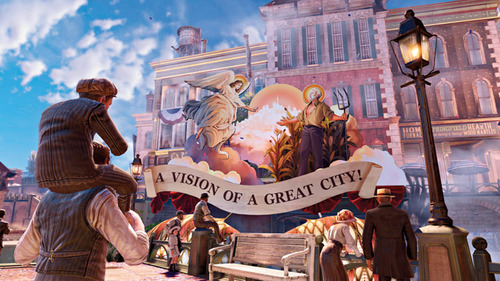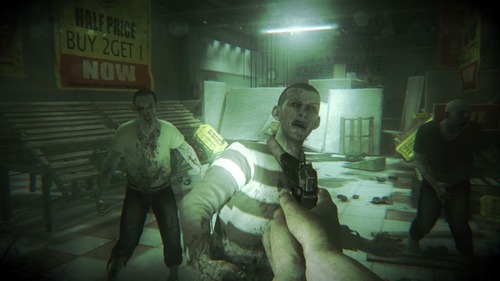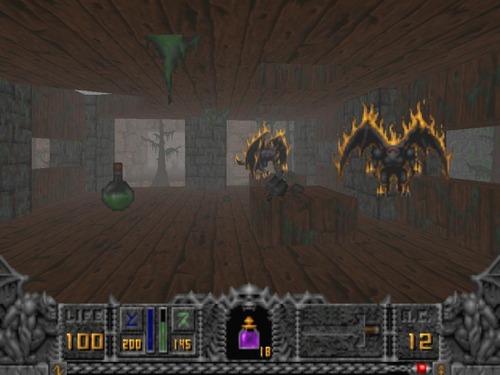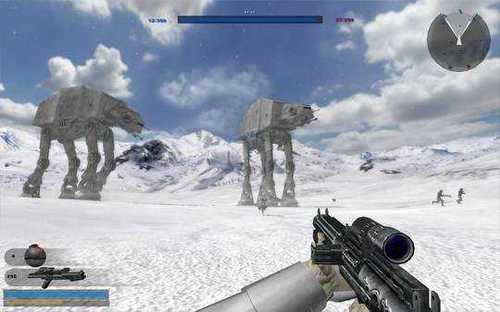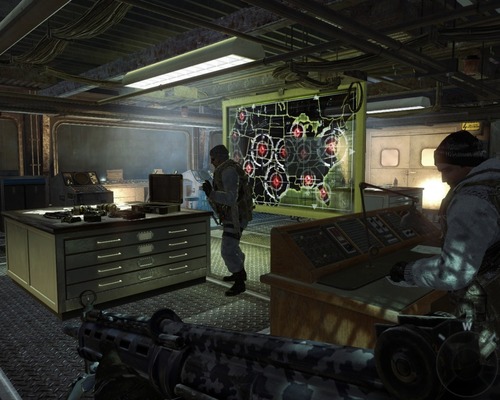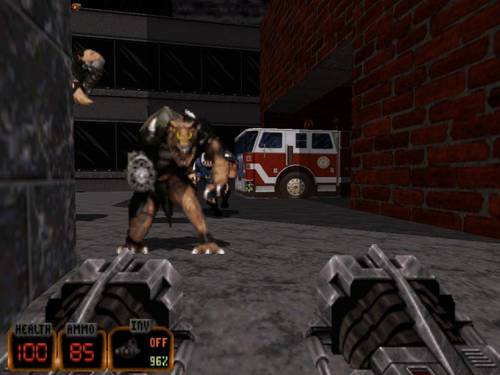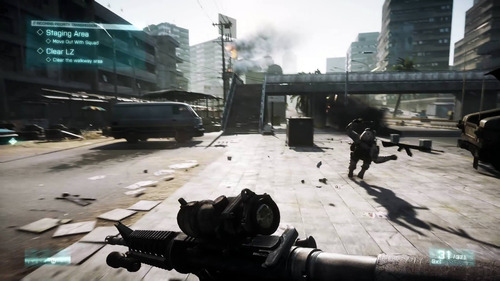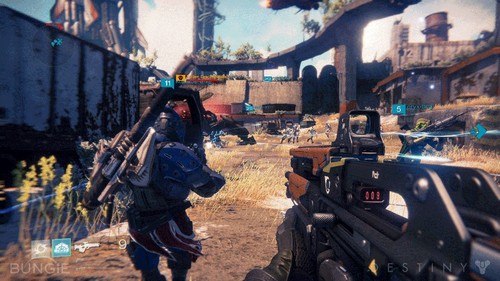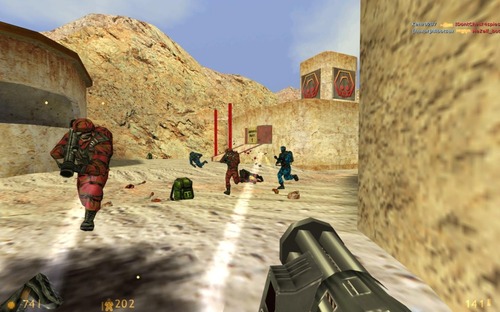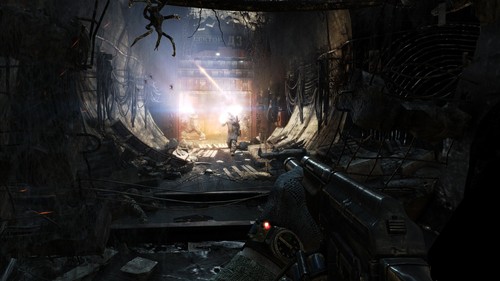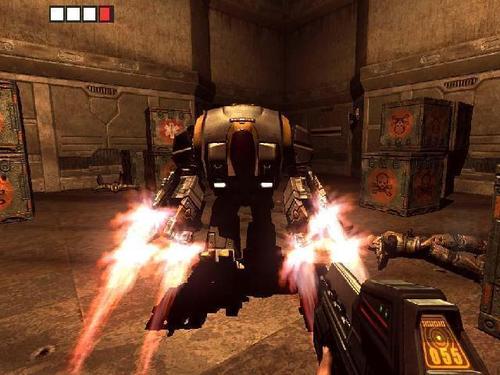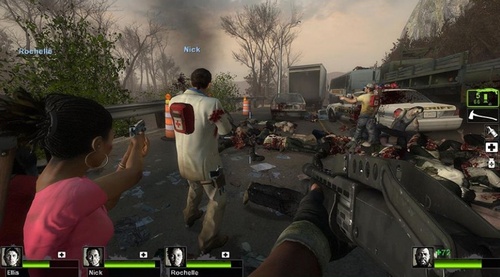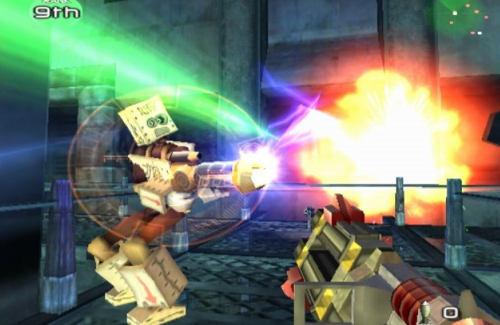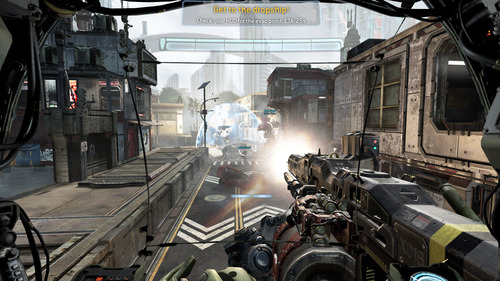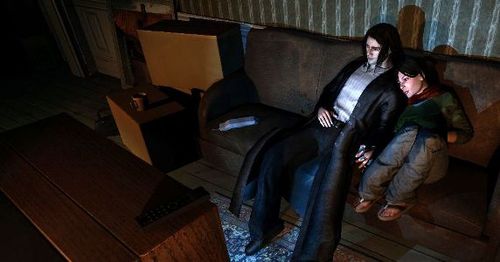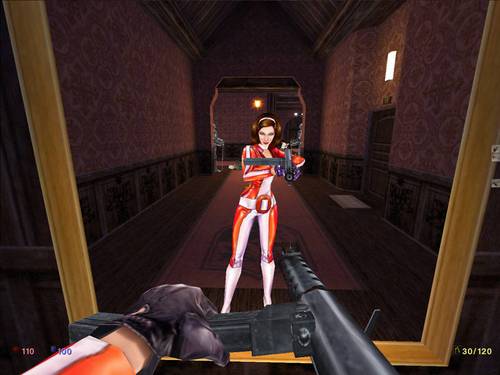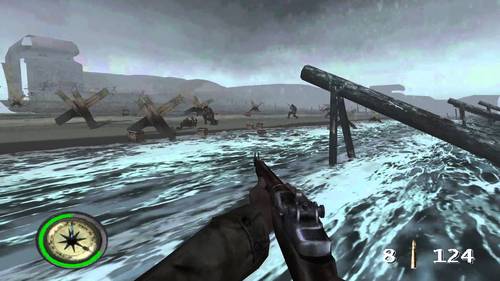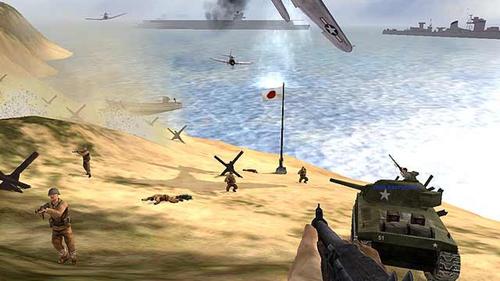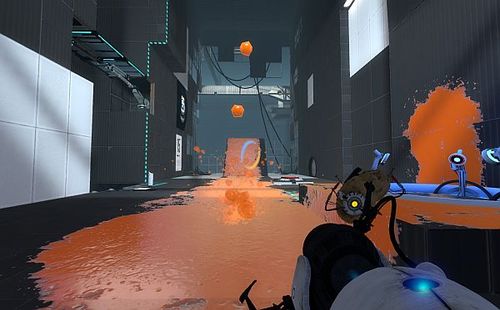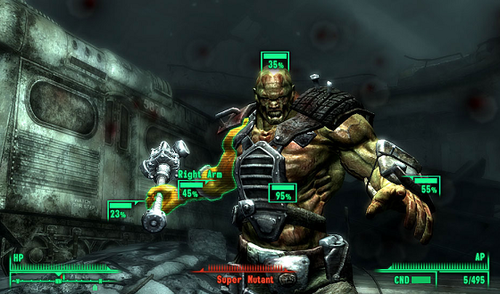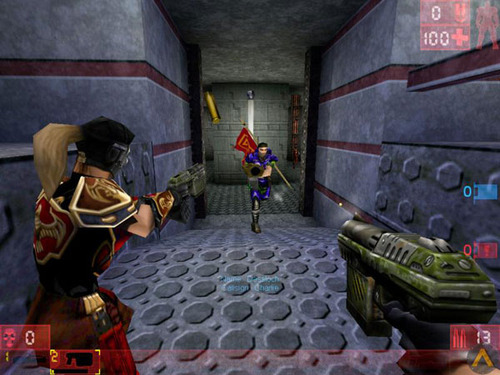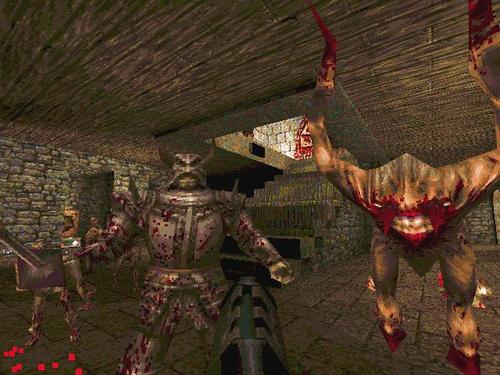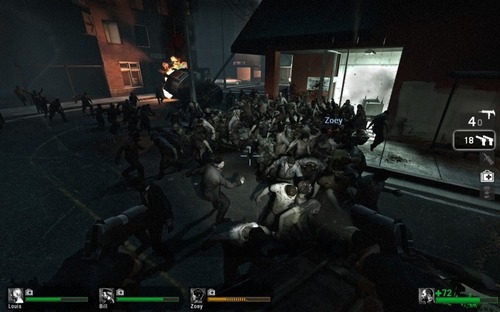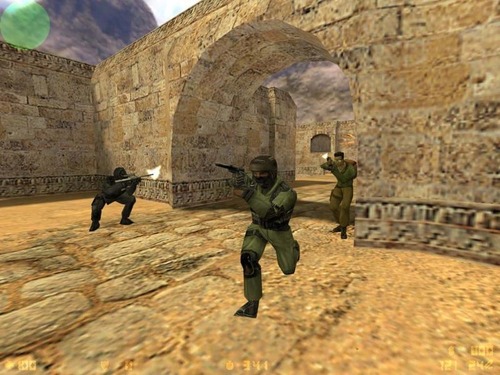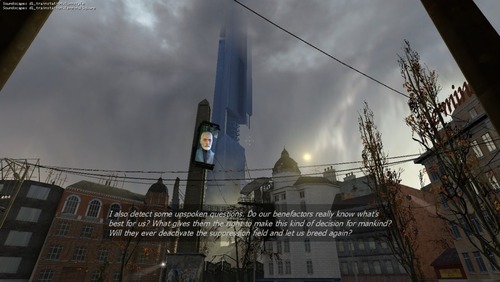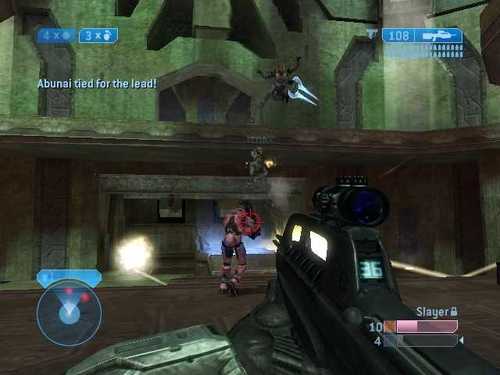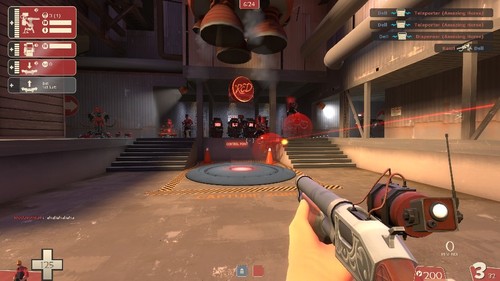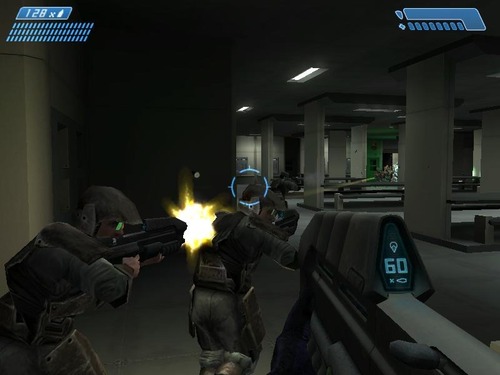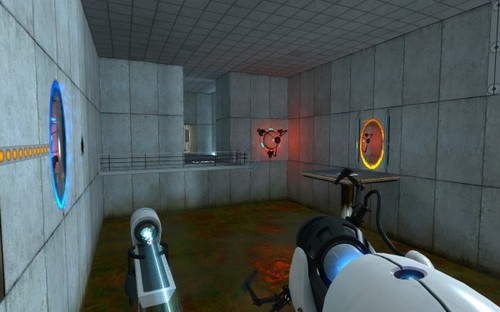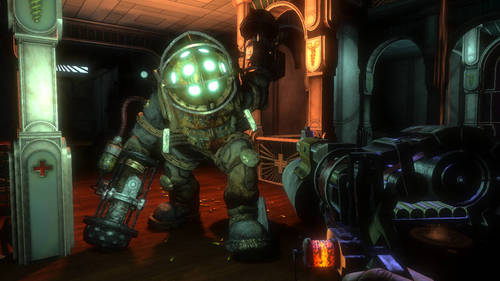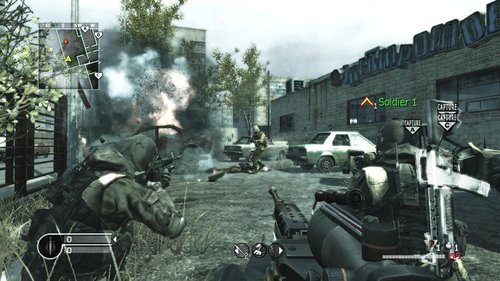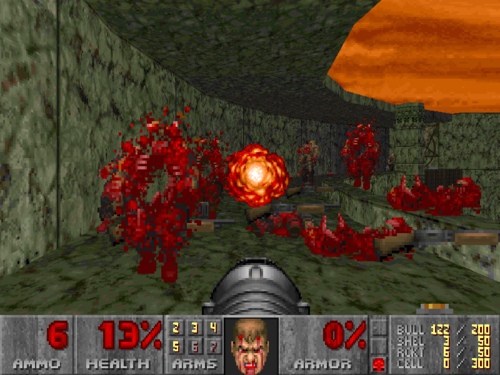The 50 Best First-Person Shooters of All Time
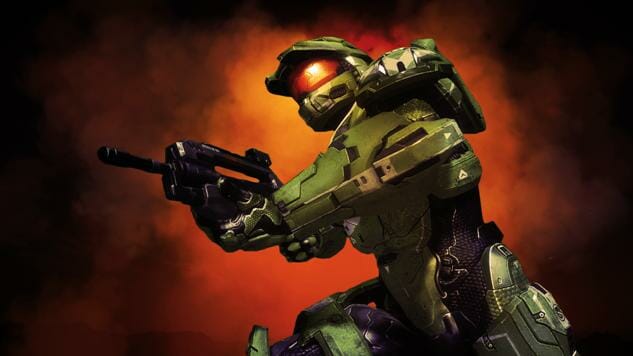
Whether you like the genre or not, it’s impossible to deny that some of the biggest and most groundbreaking games ever made have been first-person shooters. In the ‘90s the shooter exploded from weird shareware files we’d download from a local BBS into the biggest genre in the medium, and it still dominates the sales charts today. Beyond commercial success, the combination of a first-person perspective and the easy-to-understand interface of shooting things has provided a reliable framework for designers to challenge and entertain players while experimenting with storytelling, world-building and notions of player choice. Paste convened a small group of knowledgeable critics and FPS aficionados to wade through the genre’s history and come up with a list of the 50 best first-person shooters ever made. The group included Javy Gwaltney, former Paste contributor and current Game Informer Associate Editor; Patrick Lindsey and Reid McCarter, game critics and co-editors of the book Shooter: 15 Critical Essays About Games With Guns; Paste contributor Suriel Vazquez; Paste news editor Jim Vorel; former Paste games intern Eric Van Allen; and Paste games and comedy editor Garrett Martin. They focused exclusively on first-person games where shooting and other forms of combat were the primary form of interaction (so no Mirror’s Edge, Gone Home or Minecraft), and where the player could directly control the character’s movements (so no “rail shooters” like Time Crisis or shooting galleries like Duck Hunt). They weighed games both on their level of craft and their significance within the medium, and came up with a list that succinctly summarizes the rise and refinement of the shooter genre. Here you’ll find some of the most iconic games of all time alongside cult hits and forgotten favorites, and all together they chart the growth of not just one genre but the entire industry, for better or worse.
50. Bioshock Infinite
2013
After a long and very public development period, Bioshock Infinite had a lot to live up to. Moving out of Rapture and into the clouds, into another part of the Bioshock multiverse, was ultimately the correct choice, broadening the scope of this universe in ways that fans could never have expected. The game’s combat doesn’t stray too far from the improvements made in Bioshock 2, and it has occasionally been criticized for having combat encounters that are too “samey” when spread out over the course of a full game, but in its best moments it’s still a blast to wreak havoc by employing both vigors and guns simultaneously. As in previous Bioshock entries, though, the moments that replay in one’s head later are hardly, if ever, the combat. In Infinite, the moment for me is lingering to listen to a hovering barbershop quartet singing The Beach Boys’ “God Only Knows.” It’s not quite the mind-blowing moment I experienced when seeing Rapture for the first time, but it’s not that far off, either.—Jim Vorel
![]()
49. F.E.A.R.
2005
F.E.A.R.’s main strength was as a hyper-focused shooter with intense combat, where enemies would dodge your grenades, and would frequently put you in situations that tested your ability to respond to changing situations. It was also touted as a horror game, but while the horror elements mostly worked as window dressing for a shooter filled with rather ordinary-looking environments, it was enough to make you believe that at some point, you’d be faced with an enemy all the guns in the world weren’t going to kill. What could possibly be scarier in a shooter?—Suriel Vazquez
![]()
48. Zombi U
2012
You only occasionally had to shoot in Ubisoft’s weird, overlooked Wii U gem, but when you did, it was about as stressful as videogames get. The goal for your underarmed scavenger was survival, and that was incredibly hard in a London plagued with masses of zombies. What made Zombi U so memorable wasn’t the speed or thrill of its shooting, but how using a gun could attract more zombies, quickly removing one obstacle while potentially increasing the number of other obstacles in your immediate vicinity. It’s also still one of the best implementations of the Wii U’s gamepad, and its attitude towards player death recalled the Souls game: when you died you would respawn as a brand new character and have to track down either your previous corpse or kill its reanimated zombie form to retrieve your old supplies. It was brutal and not always user-friendly, but took a smart approach to both first-person action and the zombie genre.—Garrett Martin
![]()
47. Hexen: Beyond Heretic
1995
The term “Doom clone” rose to prominence in the mid-late ‘90s, and with good reason. Hexen is simultaneously a clone of Doom and its own separate beast. Made in the Doom engine, the developers jettisoned any other hint of the game’s origin. Corridors and big guns were put aside for axes and hub-and-spoke-style level design. Hexen is clearly rooted in Doom, but it uses that lineage to its advantage instead of being held back by it.—Patrick Lindsey
![]()
46. Star Wars: Battlefront II
2005
Star Wars: Battlefront II is the strongest argument to date that there’s more to Star Wars than lightsabers and Jedi. The game captured the large-scale chaos of a ground war and tried to contain it within the pristine bubble of the Star Wars universe. Developer Pandemic was keen to incorporate as many elements of the classic sci-fi universe as possible, letting players fight it out on the ground or in the vacuum of space—or both at the same time.—Patrick Lindsey
![]()
45. Star Wars Jedi Knight: Dark Forces II
1997
If the first Dark Forces was well-received just because it was our first glimpse of the Star Wars universe in a first-person shooter, Jedi Knight earned every bit of its critical adoration as a much better game and realization of the Star Wars universe. The production values were just through the roof for the time, with full-motion video and a full cast of actors lending the world a cinematic feel. The levels were huge and expansive, contributing a feeling of massive scale. The shooting was likewise fine, but the game really came alive when Kyle Katarn set down his path toward Jedi knighthood and the various force powers were unlocked. To say that they transformed the game is an understatement, as powers such as force speed and force jump completely changed which areas you’re able to access. Between this game and its Mysteries of the Sith expansion, it’s one of the best single-player stories ever told in the Star Wars universe.—Jim Vorel
![]()
44. Call of Duty: Black Ops
2010
Building on the storytelling of previous Call of Duty titles, Black Ops jumped the series forward to the Vietnam and Cold War era, where conspiracy and paranoia ran highest. Amidst a campaign of the usual explosions and grandeur was a spy thriller, one that kept you guessing until the end. You couldn’t go anywhere without hearing a reference to “The numbers, Mason! What do they mean?!” The multiplayer of both Black Ops and its sequel is still regarded as some of the best of the series, and it showed that Infinity Ward didn’t stand alone—Treyarch was there to make something every bit as influential as Modern Warfare.—Eric Van Allen
![]()
43. Duke Nukem 3D
1996
It’s almost a little embarrassing to go back today in 2015 and profess any admiration or fondness for 1996’s Duke Nukem 3D, especially following the fiasco of Duke Nukem Forever, but like it or not, this game forms part of a triumvirate with Wolfenstein 3D and Doom as the best early shooters. And honestly, compared to those earlier titles, Duke Nukem 3D was an FPS that truly had personality and character rather than the faceless nature of Doom Guy. Duke’s hyper-macho quips are juvenile, but in a time when the market was largely seen as prepubescent boys, it made sense. The gameplay, meanwhile, was quite a step forward from anything people had seen before, with its destructible level designs and multiple pathways. The weapon designs were likewise awesome—who can forget the first time they shrunk an enemy with the shrink ray and then stepped on them like a bug? That particular style of weapon has never been done as well again in an FPS in the last 20 years.—Jim Vorel
![]()
42. Battlefield 3
2011
The name’s fitting: Battlefield has always been devoted to large, sprawling, multiplayer battles with more combatants than most games allow. Battlefield 3 hinted at the confusion and fury of war more than its Call of Duty competition, a series whose games typically feel more scripted and confined. If the Call of Duty games were arcade shooting galleries, Battlefield 3 was basically a military sandbox. With the right crew, it could be more complex and more thrilling than almost any other military shooter.—Garrett Martin
![]()
41. Destiny
2014
There were many valid complaints about Destiny when it first came out, and despite many updates and additions it’s still not a game for everybody. It tried to unite an MMO framework with action reminiscent of Halo, which, of course, Destiny’s creators also made. Some might have complained about Destiny’s repetition and relatively empty worlds, but others loved its emphasis on loot and co-op play, and especially its system of “strike” missions. Regardless of whether you enjoy Destiny or not, it’s hard to deny that it’s a unique approach to creating a first-person shooter.—Garrett Martin
40. Team Fortress Classic
1999
Team Fortress Classic is a grittier, uglier predecessor to the brightly polished, funny, well-written game we know today in Team Fortress 2. It was meant to show off the capabilities of Half-Life mods, and at this it was hugely effective—it’s funny to think how many other Half-Life mods must have been spiritually inspired by Team Fortress. It was likewise massively influential on the very idea of class-based shooters, building on the limits of its Quake mod inspiration to establish class roles that have remained in place ever since. “Heavy weapons guy” and “medic” are archetypes that you can trace straight back to this game. The series continues to succeed today thanks mostly to balance—every single class can be truly fun, useful and rewarding to play when the situations are right. Although I will argue that, in the end, there’s no experience in Team Fortress more satisfying than snatching the flag as a scout and dashing all the way back across 2Fort to bring home the winning score.—Jim Vorel
![]()
39. Metro: Last Light
2013
The world of Metro never let you forget that you were in a nuclear wasteland. Ammo was currency, and decisions were constantly made between an upgrade or having enough bullets to survive. Weapons were slapped together with shoddy workmanship and your flashlight was a crank tool that often flickers out. Every venture out into the dark underground Russian metro tunnels was dangerous, but human life was forced to stay there due to the ravenous mutated creatures that tormented the surface. Among all this was a story of hope, of a possible future where Artyom and the people of the metro could find peace, and possibly a way to live above again. Expanding on the world introduced in 2033, Last Light was an atmospheric game that never let you forget the light at the end of the tunnel—as long as you didn’t let your light flicker out for too long.—Eric Van Allen
![]()
38. The Chronicles of Riddick: Escape From Butcher Bay
2004
The Chronicles of Riddick: Escape from Butcher Bay made you earn your first gun far more than any other shooter I can think of. Plenty of games teach you how to crouch, jump or sneak before letting you pull a trigger, but few have ever had you do a whole series of fetch quests (in prison, no less!) for hours before turning into a “proper” shooter. From there, the mix of shooting, sneaking and some well-executed environmental storytelling made Butcher Bay feel like the future of games, offering something for every kind of player. That it was a licenced product made how well each of these aspects came together all the more surprising.—Suriel Vazquez
![]()
37. Left 4 Dead 2
2009
It’s hard to separate Left 4 Dead from its predecessor: there was only a year between them, and despite new characters, a new mode, some new enemies and improved AI, 2 feels a lot like the original. And although I like it more (the Southern setting appeals to me, and although the humor loses some of its understated charm by making it more prominent, it’s still legitimately funny most of the time), the second game wasn’t as important or groundbreaking as the original. It was harder, though, which increased the need for communication and tight teamwork, which in a way made Left 4 Dead 2 a better realization of what the first game was aiming for.—Garrett Martin
![]()
36. TimeSplitters 2
2002
One of the unsung heroes of couch co-op shooters, TimeSplitters 2 was a standard at many late-night LANs for several years. It brought mods and mutators to the consoles, something few had done and none to the degree TimeSplitters did. Its mix of goofy antics and smooth, effective controls made it perfect for split-screen multiplayer, while still having a fun and engaging single-player run. Plus, it had a monkey that dual-wielded assault rifles. There’s never been a bad game with dual-wielding monkeys.—Eric Van Allen
![]()
35. Titanfall
2014
Titanfall brought a jolt of kinetic energy to Call of Duty-style shooters, letting players run along walls and leap stories into the air and making almost full use of the verticality of its maps. It also smartly let all players feel useful in team matches, regardless of their abilities, both by including AI grunts on every map and making defense more important than in most shooters. Oh, it also had mechs. Titanfall innovated within the current FPS template while also being more hospitable to new players than most such games, making it one of the best shooters of the current console cycle.—Garrett Martin
![]()
34. Bioshock 2
2010
What felt at first like an unnecessary retread of the remarkable original gradually turned into one of the most poignant and emotionally resonant shooters ever made. Instead of just retracing the original’s steps through Rapture, Bioshock 2 made you feel the pain of the people whose lives were ruined by Andrew Ryan’s dream, potentially culminating in a memorable player sacrifice. The Minerva’s Den DLC, some of whose creators would go on to make Gone Home, was even stronger.—Garrett Martin
![]()
33. The Darkness
2007
Starbreeze had a knack for making great games out of bad licenses. With The Darkness they turned a laughable comic book into a Grand Guignol of a game that delicately weaved over-the-top gore with some of the quietest and most human moments found in any shooter. This is a game where, depending on what hardware you’re playing on, you could watch the entirety of To Kill a Mockingbird from your character’s perspective as he snuggled quietly with his girlfriend on the couch. Some of the designers behind The Darkness also worked on The Chronicles of Riddick: Escape from Butcher Bay and Wolfenstein: The New Order, two other games on this list that mixed surprising character development with original ideas for first-person shooter set-pieces.—Garrett Martin
![]()
32. The Operative: No One Lives Forever
2000
No One Lives Forever isn’t available anywhere for digital purpose thanks to the bureaucracy of game publishers, and that’s a goddamn crime. NOLF is not only a great first-person shooter starring a witty, charming heroine, it’s also a hysterically funny send-up of spy movies from the 60s. Also, you got to use a briefcase containing a missile launcher, so y’know, it reaches the top 50 for that alone.—Javy Gwaltney
![]()
31. Call of Duty
2003
After years of World War II shooters, it’s easy to think there was little room for innovation. There was still Infinity Ward, though; a studio formed from the makers of Medal of Honor: Allied Assault, who created a series that would persevere long into the present day with Call of Duty. Adding even more storytelling and blockbuster sequences, while creating a new and inventive style of multiplayer, Call of Duty solidified itself as the definitive World War II shooter, and one of the best of the era.—Eric Van Allen
30. Perfect Dark
2000
James Bond may be the name everyone remembers, but Joanna Dark is the true professional. Perfect Dark exceeded the reach of Goldeneye 007, its predecessor, in nearly every way other than popularity. Not only was the game more technologically innovative, but it was thematically groundbreaking as well, quietly subverting standard notions of videogame heroism through its artfully understated female protagonist.—Patrick Lindsey
![]()
29. Medal of Honor: Frontline
2002
If you didn’t own an Xbox or a PC that could play cutting edge games at the dawn of the 21st century, this PlayStation 2 and GameCube classic was probably your favorite first-person shooter of the era. The fourth game in this classic World War II shooter series wasn’t the first to bring dual joystick controls to consoles, but it was one of the earliest ones outside of Halo to combine that standard shooter set-up with a fully realized campaign and well-designed levels. Both the Medal of Honor series and the World War II shooter genre quickly wore themselves out, but Frontline remains one of the more significant first-person shooters ever released.—Garrett Martin
![]()
28. Battlefield 1942
2002
Battlefield 1942 had (and the series continues to have) the greatest single-song soundtrack in game history, but that’s just the icing on the cake. The original BF 1942 is a game I sunk many hours into, because it offered so many memorable experiences. In its base form, the game was an arcade-friendly WWII shooter that was groundbreaking in how seamlessly it was able to incorporate vehicles such as jeeps, tanks, planes and even battleships into frenetic, fast-paced gameplay, while also allowing for creative kills and the ridiculous stunts that are still the series’ trademark. Simultaneously, though, the original game was also followed by some fantastic total conversion mods, from the jungle-based Vietnam combat of Eve of Destruction, to WWII realism mod Forgotten Hope. The latter, in its original iteration, hits a near-perfect level of realism that makes each of the armies distinct and different (rather than simply clones of each other) while still maintaining just enough of its arcade origins for gameplay to remain vital and addicting. All in all, though, BF 1942 laid down a format so effective that the series has barely deviated from its basic structure in 13 years.—Jim Vorel
![]()
27. Doom II
1994
What else could Doom II ever be but the sequel to Doom? The game certainly had big shoes to fill, but it rose to the challenge admirably. The game mostly stayed true to the design philosophies and beats that made the first one so seminal, but added in enough new surprises to keep from growing stale.—Patrick Lindsey
![]()
26. Quake III Arena
1999
Since I could first reach the keyboard, I was playing Quake III Arena. At first, I marveled at its explosions and railgun blasts, but as I grew older and played more shooters I came to appreciate what Quake III Arena was. It was part of the pinnacle of arena-based shooters, one that emphasized movement and positioning just as much as accuracy. Learning the routes, the power-up spawns, the perfect route to bunny-hop along was important, but it also stood strong as a polished and engaging shooter that provided an experience nothing else could.—Eric Van Allen
![]()
25. Borderlands 2
2012
A melting pot of loot-based role-playing games and first-person shooters, Borderlands 2 stands head-and-shoulders above its predecessor because of the universe it created. Borderlands 2 took the barebones formula before it and fleshed out an entire world for Pandora, with a solid story, unique locales and a memorable cast of characters. Using Handsome Jack as a Big Bad to tie the whole plot together let a repetitive loot-shooter become a comedic spectacle shooter with a lot of heart, especially in Tiny Tina’s add-on pack.—Eric Van Allen
![]()
24. Wolfenstein: The New Order
2014
I don’t get into arguments often. I’m mostly content to let people shout whatever they want no matter how silly it is or how much I disagree with it. Except when it comes to Wolfenstein: The New Order, a game I’m downright belligerent and obnoxious about. I will yell at you if you don’t like it. I will drown you in a hundred copies of the game until you swear your allegiance to it. It’s the best shooter since Half-Life 2 and I’ll take on anyone who says differently. The game’s combination of powerful gunplay and a thematically rich narrative about a man dragging himself into the arena for one last fight against fate is equal parts exhilaration and tragedy. An absolute must-play for anyone who likes games that involve shootin’ dudes.—Javy Gwaltney
![]()
23. S.T.A.L.K.E.R.: Shadow of Chernobyl
2007
S.T.A.L.K.E.R.: Shadow of Chernobyl was a mean game. There was a palpable hostility that came not just from the game’s bloodthirsty monsters and bandits, but also from the irradiated hellscape of its setting. Shadow of Chernobyl’s unforgiving design was what made it work, though. The developer’s vision of a Pripyat, Ukraine ravaged yet again by nuclear catastrophe was uncompromising in its difficulty, but—for the grim, survivalist story it told—that was pretty much the point. —Reid McCarter
![]()
22. Portal 2
2011
Porta 2 might not have had the purity and elegance of the original, but it more than made up for it by showing that some ideas have too much staying power than a single game can muster. By introducing paint, light beams and other gadgets, Portal 2 gave its core conceit new life. It knew when to shift gears and give you something new to do, never letting you settle into tedious rhythms. Even better, it fleshed out the characters and backstory of the original Portal without giving too much of that game’s mystique away—something few game sequels can claim.—Suriel Vazquez
![]()
21. Fallout 3
2008
We’re used to the style now, but, in 2008, Bethesda Game Studios’ enormous worlds and free-form character development felt incredibly novel. Fallout 3’s post-apocalyptic take on East Coast America was packed with stories to uncover, each providing the player opportunity to refine their character’s personality through moral and martial choice. The blend of tactical decision-making and reflexive first-person shooting that Bethesda managed to concoct for Fallout 3’s time-slowing V.A.T.S. system helped make the game’s most violent moments pretty memorable, too. —Reid McCarter
20. Metro 2033
2010
Metro 2033 was a game where you played as a soldier trying to survive the deadly Russian metro after a devastating nuclear attack sent Moscow’s survivors underground, many of them breaking off into political factions that tried to kill or enslave each other when they weren’t fighting bloodthirsty monsters. On the whole, Metro 2033 actually wasn’t that special outside of its spooky, sad story…until you turned the difficulty up to “Ranger,” which gave both you and your armed opponents the ability to one-shot each other. It was a great option that made every firefight incredibly tense and tactical, a quality more first-person shooters need to have.—Javy Gwaltney
![]()
19. Unreal Tournament
1999
It’s weird to call a game about people jumping around and turning each other into fine paste with a variety of deadly weapons “sophisticated” but Unreal Tournament proved to be a stark contrast to the straight forward bloodbath of Quake and Doom thanks to the variety of modes and mutators it gave players to toy around with. Wanna play Capture the Flag in low gravity with guns that kill opponents in one hit? You could do that! Of course, regular old Deathmatch was just as satisfying thanks to the tight controls and creative weapons (the nuke-throwing Redeemer remains a personal favorite). And no first-person shooter since has come close to making earning killstreaks so much damn fun: Muh-muh-muh-MONSTER KILL-KILL-KILL-KILLLLL.—Javy Gwaltney
![]()
18. Quake
1996
It may sound shallow, but improvements in technology are what made Quake noteworthy. Its level design and monsters—maybe even its selection of guns—don’t quite stack up to what id Software produced in Doom. But, the higher fidelity sound and music, the integration of 3D mouse aiming and a far more accessible online multiplayer mode all worked together to make it a landmark shooter. —Reid McCarter
![]()
17. Left 4 Dead
2008
I don’t know if Left 4 Dead was a perfect co-op shooter, but it was probably closer than any other game (besides possibly Left 4 Dead 2). Every design decision was focused towards maximizing its co-op appeal, making it basically unthinkable to play without friends, even if the game let you. And it didn’t just nudge you towards your friends, but made sure you would genuinely play along with them, instead of ever trying to abandon them or play ahead of them. Essentially structuring every campaign as a 90-minute film was also a crafty call, as it insured a decently long play session while also providing a hard stopping point for those who didn’t want to get sucked too deeply into a game. It was also really funny without ever beating players upside the head with how funny it was supposed to be, which is still almost unheard of in videogames. It’s a toss-up as to which Left 4 Dead was better, but the importance and impact of the original can’t be diminished.—Garrett Martin
![]()
16. Metroid Prime
2002
Metroid Prime took the chief hallmarks of Nintendo’s beloved space adventure and remade them into a perfect game for the first-person shooter generation. The FPS framework made Prime feel unlike any previous Metroid, while the classic Metroid focus on exploration and retracing your steps made it feel unlike any other first-person shooter. It tapped into that addictive rhythm of progress and reward expected from Metroid and its many derivatives, but added an edge of engrossing, fast-paced action expected from a shooter. And between its optional data scans and environmental storytelling, it depicted a fallen world in a relatively understated fashion, offering lessons designers could still learn from today. Its two fine sequels also deserve recognition, but Metroid Prime’s legacy can’t be undersold.—Garrett Martin
![]()
15. Counter-Strike
1999
You could argue that Counter-Strike was noteworthy because of its design or you could argue the game’s importance came from its implications, and either way you’d be right. One of the most extensive total-conversion mods to-date, the game, which began its own life as a fan-created mod, helped usher in a new golden age both of modding and competitive gaming.—Patrick Lindsey
![]()
14. Deus Ex
2000
More than anything else, Deus Ex was a playground. By blending role-playing conventions (like free-form character development and dialogue choices) with stealth and shooter design, Deus Ex allowed the player to define their own version of protagonist JC Denton through action rather than exposition alone. The goofy cyberpunk conspiracy story, which found a way to rope in everything from Area 51 to the Illuminati, lent a fantastic, sinister tone to the game, making it a wonderful snapshot of Western culture in the early days of a new millennium. —Reid McCarter
![]()
13. Half-Life 2
2004
Half-Life 2’s enduring legacy might be that it doesn’t have a sequel, but like the imposing Combine Citadel casting its shadow across City 17, it acts as a center, a reference point for shooters years later. Its shooting felt refined, its plot immersive and unobtrusive, and its world-building impressive. Going back and playing it years after its release has only made me realize how few steps forward the genre has taken narratively since 2004, and how much of a mark the game has left. Half-Life 2 might be tame by today’s standards, but like a good crowbar, its simplicity of form gives it its powerful durability.—Suriel Vazquez
![]()
12. Halo 2
2004
Halo may have been a revolution for Xbox players, but Halo 2 took the designs and concepts and mastered them to make what still stands as the best Halo multiplayer today. The addition of dual-wielding added depth to the weapon pool, and signature maps like Headlong and Containment became as eponymous as Blood Gulch. This was the refinement of the plan, one that led to many late nights and LAN parties for years to come, and one of the defining titles of the original Xbox’s run.—Eric Van Allen
![]()
11. Wolfenstein 3D
1992
Id Software may have perfected their style of first-person shooter with Doom, but that wouldn’t have been possible without the lessons learned developing Wolfenstein 3D. The groundwork for (so, so, so) many games to come, Wolfenstein 3D showed that a shooter can be set in an environment that resembles the real world—that it can have enough of a story and enough of a mood that the player feels as though they’ve been transported to another world entirely. —Reid McCarter
10. Team Fortress 2
2007
Team Fortress 2 made multiplayer shooters intuitive. The exaggerated Tex Avery-esque caricatures helped even the most novice of players understand how their role should define their play; the Heavy was large and slow, which made playing him as an unstoppable wall a no-brainer, for example. The variety of roles also meant you didn’t always have to throw yourself into the grinder; Spies could sneak around and take kills and objectives, Medics could win games without firing a single shot, and Engineers could focus on playing the map rather than the enemy. You could subvert brute-force tactics in sly ways, which gave the game the variety it needed to maintain its presence all these years later.—Suriel Vazquez
![]()
9. GoldenEye 007
1997
It’s probably safe to say that GoldenEye is the most influential console shooter of all time—the game that took first-person shotoers from being thought of exclusively as a PC gamer’s domain into one of the most common console genres. It’s a game with a massive amount of nostalgia backing it, the fuel for so many late-night 4-player deathmatches in The Stacks, The Facility, and other iconic levels. It set standards for first-person shooter weapons that have been tropes ever since—tell me that the phrase “proximity mines” doesn’t immediately make you think of GoldenEye. The goodwill toward it still makes fans overlook lot of the issues the game had, and it doesn’t hold up all that well today in either single or multiplayer modes, which are crippled by the incredibly clunky controls and inability to see more than 20 feet into the distance … but none of that really matters. The memories of playing GoldenEye are perhaps the singular experience of the N64 era, and they can’t be tarnished.—Jim Vorel
![]()
8. System Shock 2
1999
If you’re looking for one of the first franchises to popularize storytelling in a first-person shooter, System Shock 2 is your answer. Before Bioshock or Deus Ex ever came about, System Shock 2 was melding role-playing game inventory systems and colored key cards with the tenets of FPS. The villainous SHODAN embodies this narrative focus, as an AI that holds the player captive like a puppet and became one of the most memorable antagonists in games.—Eric Van Allen
![]()
7. Halo: Combat Evolved
2001
More than just a shooter series, Halo helped Microsoft establish console supremacy. Like a cool older brother, Halo introduced console gamers to first-person shooters, borrowing genre conventions where possible and improvising where needed. It’s a rare game whose online and offline game modes are equally strong, but Halo is one of the few that can make such a boast.—Patrick Lindsey
![]()
6. Portal
2007
Portal was a shooter where you didn’t really shoot anything. Instead of bullets or lasers you used that portal gun to open up doorways and solve increasingly elaborate puzzles. You might have had to destroy some turrets and robots along the way, but it was a relatively non-violent game. Portal has had as much impact on game design since its release as any other game. Before episodic games were routine, it proved that players would feel satisfied with a three-hour game as long as it was designed well enough. It doubled down on Valve’s commitment to environmental storytelling, while also introducing an unreliable narrator as an antagonist, twisting what players expect from a game. It was also legitimately funny, which, as mentioned earlier in this list, is always a rarity within the world of videogames.—Garrett Martin
![]()
5. Bioshock
2007
Bioshock’s binary moral choices and audio diaries may have been an unfortunate precursor to some of the worst modern videogame design trends. But, it had a more positive influence, too, in its willingness to attempt a holistic merger of shooter conventions and narrative. Bioshock is an uncommon game in that it actually has a point to make and devotes itself fully to arguing it through visuals, gameplay and story. That’s a low narrative bar, sure, but it’s also one that still isn’t cleared as often as many players might hope.—Reid McCarter
![]()
4. Far Cry 2
2008
Before there was Jason Brody or Ajay Ghale, there was just the player, and Africa. Far Cry 2 stood out from its progeny because of its lean approach to thematic and mechanical design. Its lightweight narrative nevertheless managed to speak volumes about the entire genre, thanks largely to the game’s repeated and brutal depictions of violence.—Patrick Lindsey
![]()
3. Call of Duty 4: Modern Warfare
2007
It isn’t strange to think of the shooter genre as two periods of time, before and after Modern Warfare. After years of creating World War II-era games, Infinity Ward ventured into risky territory. There’s a lot that was ambitious about Call of Duty 4: a persistent progression system, the concept of “loadouts,” a new era and the changes that brings to every gun and instance of gameplay. What resulted was a game that still defines console shooters today, with a mix of Call of Duty’s excellent single-player experiences and the blueprint for multiplayer shooters to come.—Eric Van Allen
![]()
2. Half-Life
1998
Half-Life, a game that’s just as much a horror game as it is a balls to the walls first-person shooter, changed gaming forever. There aren’t many games you can say that about, but Valve’s shooter struck an impressive balance between realism and goofy sci-fi, and turned the player into the cinematographer of the game’s story by giving them control of an extended 10 hour single take instead of bombarding them with cutscenes or forcing them to read through page after page of exposition. It was an exciting design that’s been copied countless times since and has become, for better or for worse, the standard for AAA videogame storytelling. Besides its technical accomplishments, Half-Life’s action setpieces are still breathtaking, particularly “We’ve Got Hostiles,” which has the player running along the side of a canyon, fighting enemy troopers and a deadly helicopter. Sure, the last fifth of Half-Life takes a strange turn into weird, awful platforming land, but not even that can derail the timeless quality of the game’s blend of action and survival-horror, intuitive enemy AI and gruesomely satisfying gunplay.—Javy Gwaltney
![]()
1. Doom
1993
Doom was, simply put, the genesis point for modern first-person shooters. Equally noteworthy for the incredible game engine John Carmack designed as for the controversy surrounding the game’s violent and demonic imagery, Doom made such a big splash in the game design world we’re still feeling its ripples today. [For more on Doom, read the essay we published on its 20th anniversary.—Ed.]—Patrick Lindsey
GET PASTE RIGHT IN YOUR INBOX
The best music, movies, TV, books, comedy and more.
